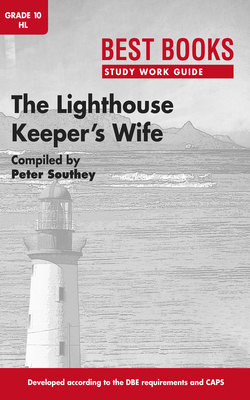Читать книгу Best Books Study Work Guide: The Lighthouse Keeper’s Wife Gr 10 HL - Peter Southey - Страница 5
ОглавлениеAnalysis and questions
Foreword (p. iv)
1.Before you begin to study something new it is helpful to search your mind for what you already know about the new matter. You have probably never heard of Freytag’s Pyramid, but what about the other items in the list? Write down what you understand the four terms below to mean.
Character
Plot
Setting
Stage directions
2. Exactly how are you going to be studying this play (actual)? Would you prefer to be studying it in some other way (ideal)? Place ticks in the boxes that apply to you in the table below.
| Actual | Ideal | |
| Studying it on my own as a text | ||
| The teacher reads the whole play aloud in class, taking all parts* | ||
| Play reading in class; four learners active, the others following in their books | ||
| Simultaneous play reading in class in groups of four | ||
| Stage production with costumes and props |
*This approach is not included in the Foreword, but it does happen.
Key features (p. 1)
1.This section lists the ways in which drama differs from other genres. Once you have read through it, write down what novels and short stories have in common with drama: in what ways is prose fiction similar to drama?
2.How does it differ?
Introduction to The Lighthouse Keeper’s Wife (p. 2)
1. What is “drama”? (p. 2)
In your own words explain what “the suspension of disbelief” means in this context: “I like going to movies with my friend Casper because we’re equally willing to suspend our disbelief.”
2. Character and characterisation (pp. 2 & 3)
Based on what we are told in this section, place ticks in the appropriate boxes in the table below:
| Type of character | Stella Lamprecht | The other three characters(Plaatjes, Adriaan Lamprecht and Barney) |
| Major character | ||
| Minor character | ||
| Round character | ||
| Flat character | ||
| Dynamic character | ||
| Static character | ||
| Protagonist | ||
| Antagonist |
3. Plot (p. 3)
In this section, the key word for a clear understanding of “plot” is written in italics. Write it in the space provided below and then explain what it means.
Word:
Meaning:
4. Conflict (p. 4)
From p. 3 of the section on Character and characterisation, quote a phrase that tells us something about the conflict in this play.
5. Structure (pp. 4 & 5)
Fill in key words in the table below to summarise the application of Freytag’s Pyramid to The Lighthouse Keeper’s Wife.
| Structure | Applying this to The Lighthouse Keeper’s Wife |
| Exposition | |
| Rising action | |
| Climax | |
| Falling action | |
| Dénouement |
6. Setting (p. 5)
This section tells us that “The setting in The Lighthouse Keeper’s Wife is particularly important” but we are not told what that setting is. Read the sections on Robben Island and the lighthouse on pp. 8 and 9 and then describe the setting in one or two sentences.
7. Stage directions (p. 5)
Add a sentence here to the notes you wrote for question 3 above, explaining how a novelist deals with the information that a playwright provides in stage directions.
8. Dialect
Read through Plaatjes’ speech on pp. 11 and 12 and quote an example from it of each of the following:
Dutch:
Cape coloured slang:
An African language:
9. Theme (p. 6)
We read here that “As each boat is about ready to launch, a prison warder destroys it and the prisoner has to start over.”
What is your view about what the warder did? What is your view about the prisoner’s reaction?
Answer one of these questions by stating your point of view in general terms. (This would be a theme if YOU were writing the play.)
10. About the author
List the four cities mentioned in the text box on p. 7 in which Charles Fourie’s plays have been produced.
About the play
1. Robben Island
In the table below fill in the approximate dates during which those listed in the first column were kept on Robben Island.
| Captives | From | Until |
| Khoikhoi | ||
| Xhosa captives during the Frontier Wars | ||
| Tuberculosis patients | ||
| Lepers and the mentally ill | ||
| Political prisoners (maximum security prison) | ||
| Convicted criminals (medium security prison) |
Oddly enough, the so-called mentally ill (“lunatics”) included homeless people, prostitutes with sexually transmitted diseases, alcoholics and those who were unemployed because of old age or ill health. This gives us reason to question whether Plaatjes really is mentally ill. He does enough talking to give you evidence to make up your own mind about this.
The other three characters were invented by the playwright, but “Plaatjes the boatbuilder” actually lived. He was an inmate in the lunatic asylum on Robben Island at the time of the play (around 1900) and he built boats from driftwood in the futile hope of sailing to freedom – futile because on completion his boats were always destroyed, just as they are in the play.
2. The lighthouse
Judging from what you read on p. 8, what was probably one of the lighthouse keeper’s most important tasks?
3. Pre-reading
a. Write down your answer to the first question under this heading on p. 9. Give your reasons.
b. Now answer the question at the second bullet and give reasons for your answer.
